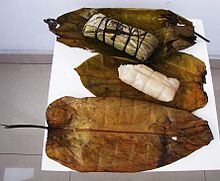Cassava bread
Manioc bread ( called kwánga in Lingála ) is a traditional side dish in the Caribbean and in the Congo basin made from manioc .
Manufacturing
In the Congo, the tubers, which contain hydric acid in their raw state, are peeled, ground and soaked for a few days. The cassava is then fermented , roasted and cooked wrapped in a banana leaf. The resulting white cassava bread has an elastic consistency and no taste of its own. However, it is nutritious and is commonly eaten as an accompaniment to a wide variety of sauces or stews. In the Dominican Republic , cassava flour is processed into waffle-like slices that are hard and dry and are also eaten as a side dish.
meaning
For a long time in the Caribbean, cassava bread was more common among the indigenous population, while other products made from cassava were generally very popular. Since the 2010s, due to the rising prices for other staple foods, the manioc cultivation has been subsidized by the state, which also increases the consumption of manioc bread. Cassava bread is the staple food in the two Congo countries.
While unprocessed cassava can only be kept for a few days, cassava bread wrapped in a banana leaf can be stored for up to 20 days, which is why it is also used as travel catering.
history
The cultivation of manioc and the production of manioc bread were already part of the diet of the indigenous people when the Italian navigator Christopher Columbus "discovered" Central America for Europe in 1492. Cassava bread spread very quickly after the Congo's first contacts with the Portuguese, who brought cassava to the region, although it is relatively complex to make.
swell
- ↑ Joachim Massamba, Guy-Mesin Adoua-Oyila, Serge Trèche, “Perception et acceptation d'une innovation technologique dans la preparation de la chikwangue à Brazzaville, Congo”, Alimentation, nutrition et agriculture , No. 1, FAO, 2001,
- ↑ Linda Bladholm: Latin & Caribbean Grocery Stores Demystified . Renaissance Books, Los Angeles 2001, ISBN 1-58063-212-2 , pp. 186 .
- ↑ Press release of the Caribbean Agricultural Research and Development Institute of September 2, 2013. Accessed April 22, 2015 .
- ↑ La Chikwangue, 2007
- ↑ Article in the Guyana Chronicle of September 29, 2014. Retrieved April 22, 2015 .
- ↑ Trèche Serge, Legros O., Avouampo E., Muchnik J., Massamba J .: Fabrication de chikwangue au Congo, Paris: ORSTOM, 1993, 99 p.
